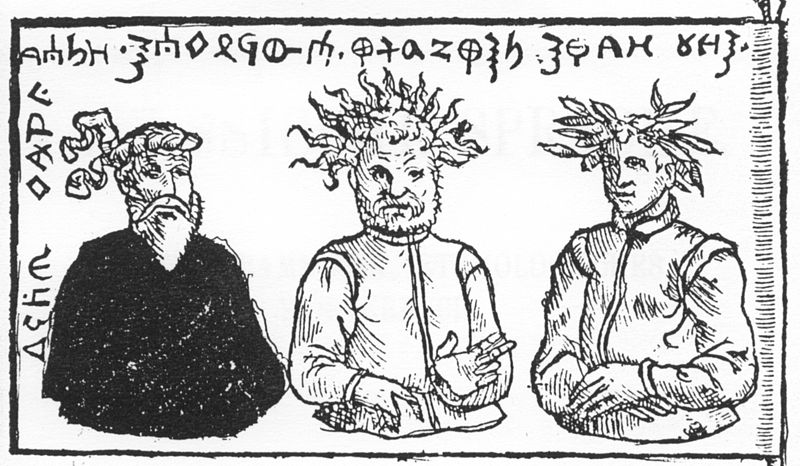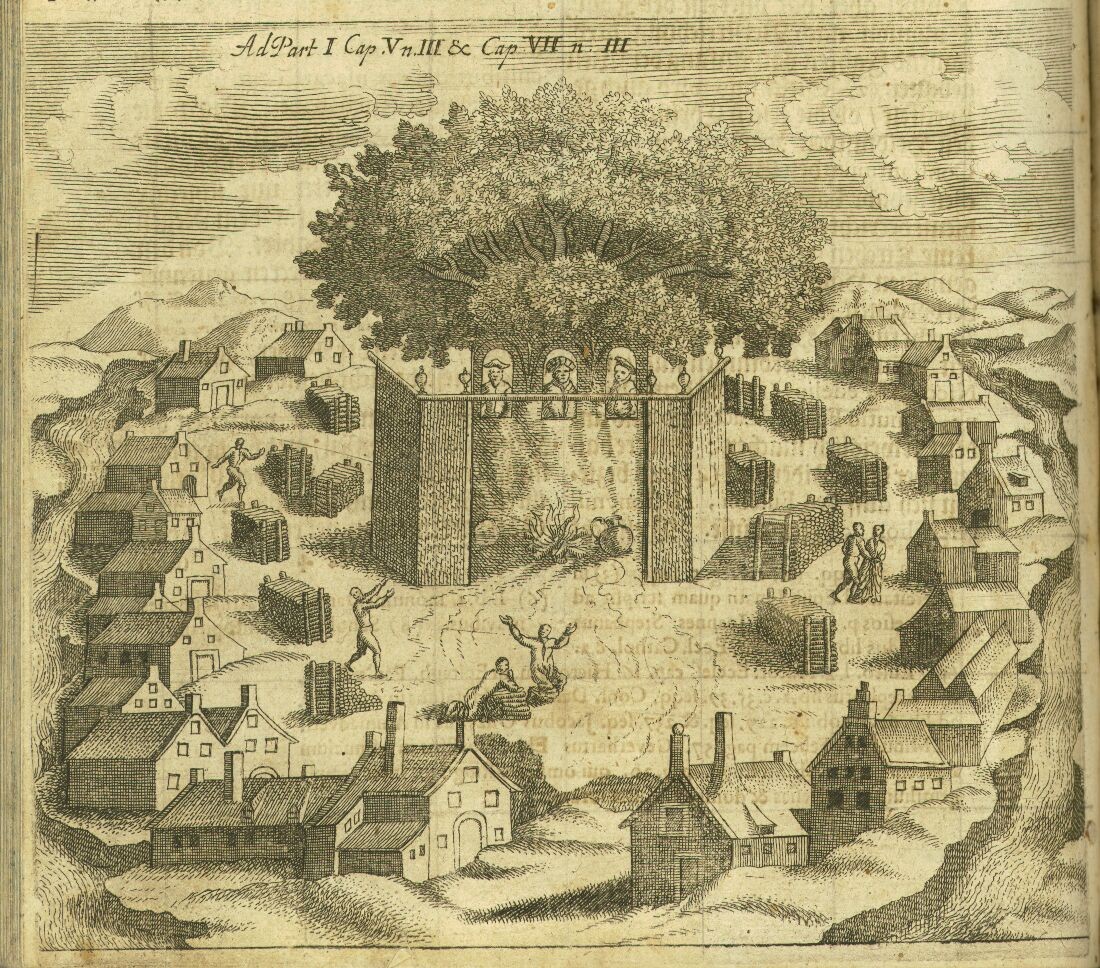|
Potrimpo
Potrimpo (also ''Potrimpus'', ''Autrimpo'', ''Natrimpe'') was a god of seas, earth, grain, and crops in the pagan Baltic, and Prussian mythology. He was one of the three main gods worshiped by the Old Prussians. Most of what is known about this god is derived from unreliable 16th-century sources. He was first mentioned (as ''Natrimpe'') in a 1418 memorandum ''Collatio Espiscopi Varmiensis'' sent by the Bishop of Warmia to Pope Martin V. The document reminded the Pope that the Teutonic Knights successfully Christianized pagan Prussians, who previously worshipped "demons" Perkūnas, Potrimpo and Peckols (and Patollo). Simon Grunau claimed that Potrimpo was a god of grain and together with thunder god Perkūnas and death god Peckols formed a pagan trinity. He was depicted on the purported Flag of Widewuto as a young, merry man wearing a wreath of grain ears. Grunau further claimed that snakes, as creatures of Potrimpo, were worshipped and given milk (cf. žaltys). The '' Sudovian Boo ... [...More Info...] [...Related Items...] OR: [Wikipedia] [Google] [Baidu] |
Prussian Gods
The Prussian mythology was a polytheistic religion of the Old Prussians, indigenous peoples of Prussia before the Prussian Crusade waged by the Teutonic Knights. It was closely related to other Baltic faiths, the Lithuanian and Latvian mythologies. Its myths and legends did not survive as Prussians became Germanized and their culture went extinct in the early 18th century. Fragmentary information on gods and rituals can be found in various medieval chronicles, but most of them are unreliable. No sources document pagan religion before the forced Christianization in the 13th century. Most of what is known about Prussian religion is obtained from dubious 16th-century sources ('' Sudovian Book'' and Simon Grunau). Historical background and sources The Teutonic Order, a crusading military order, began the Prussian Crusade in the 1220s. Their goal was to conquer and convert pagan Prussians to Christianity. The Knights built log and stone fortresses, which proved to be impregnable ... [...More Info...] [...Related Items...] OR: [Wikipedia] [Google] [Baidu] |
Perkūnas
Perkūnas (, , Old Prussian: ''Perkūns'', ''Perkunos'', Sudovian language, Yotvingian: ''Parkuns'', Latgalian language, Latgalian: ''Pārkiuņs'') was the common Baltic languages, Baltic List of thunder gods, god of thunder, and the second most important deity in the Baltic Pantheon (gods), pantheon after Dievas. In both Lithuanian mythology, Lithuanian and Latvian mythology, he is documented as the god of sky, thunder, lightning, storms, rain, fire, war, law, order, fertility, mountains, and oak trees. Etymology The name continues PIE ''*'', cognate to ''*'', a word for "oak", "fir" or "wooded mountain". The Proto-Baltic language, Proto-Baltic name *''Perkūnas'' can be reconstructed with certainty. Slavic Perun is a related god, but not an etymologically precise match. Finnish people, Finnish Perkele, a name of Ukko, is considered a loan from Baltic. Another connection is that of ''terpikeraunos'', an epithet of Zeus meaning "''who enjoys lightning''". Perkūnas in wri ... [...More Info...] [...Related Items...] OR: [Wikipedia] [Google] [Baidu] |
Peckols
Peckols and Patollo (known under a multitude of different names) were gods in the pagan Prussian mythology who were worshiped by the Old Prussians. Most researchers believe that, despite varying names, Peckols and Patollo were probably the same god in charge of the underworld and the dead. It is usually described as an angry, evil spirit similar to the Lithuanian Velnias. ''Patollu'' was first mentioned in 1418, by Bishop of Warmia in a letter to the Pope. Chronicler Simon Grunau (1529) provided more vivid but dubious details about ''Patollo''. According to Grunau, ''Patollo'' was one of the three gods portrayed on the flag and coat of arms of King Widewuto and worshiped in the temple of Rickoyoto. He was portrayed as an old man with a white beard and a white headdress similar to a turban. He was a frightening and ruthless god of the dead who would haunt and taunt the living if they disobeyed their pagan priests or buried the dead without proper sacrifices to the gods. Many o ... [...More Info...] [...Related Items...] OR: [Wikipedia] [Google] [Baidu] |
Widewuto
Widewuto or Videvutis (also ''Viduutus'', ''Vidvutus'', ''Witowudi'', ''Waidewut'', ''Vaidevutis'') was a legendary king of the Prussian mythology, pagan Baltic Prussians who ruled along with his elder brother, the high priest (''Kriwe-Kriwajto'') Bruteno in the 6th century AD. They are known from writings of 16th-century chroniclers , Simon Grunau, and Lucas David. Though the legend lacks historical credibility, it became popular with medieval historians. It is unclear whether the legend was authentically Prussian (i.e. recorded from Prussian mythology) or was created by Grunau (possibly inspired by Biblical Moses and Aaron), though Lithuanian researchers tend to support its authenticity. Names Widewuto's name is found in literature in different forms: Veijdenutus, Vydevutis, Vidowuto, Viduutus, Waidewut, Wejdewut, Wenedut, Widewuto, Widewutte, Widiwutus, Wydowudo, Wydowudus, Widowuto, Wydowuto, Widowutus, Witoud, Witoudo, Witouito, Witowudus, Witowuto, Wotowudo, Vaidevutis (moder ... [...More Info...] [...Related Items...] OR: [Wikipedia] [Google] [Baidu] |
Romuva (temple)
Romuva or Romowe (also known as Rickoyoto in the writings of Simon Grunau) was an alleged pagan place of worship (a temple or a sacred area) in the western part of Sambia, one of the regions of pagan Prussia. In contemporary sources the temple is mentioned only once, by Peter von Dusburg in 1326. According to his account, Kriwe-Kriwajto, the chief priest or "pagan pope", lived at Romuva and ruled over the religion of all the Balts. According to Simon Grunau, the temple was central to Prussian mythology. Even though there are considerable doubts whether such a place actually existed, the Lithuanian neo-pagan movement '' Romuva'' borrowed its name from the temple. Historical accounts According to Peter von Dusburg, writing in 1326, the name ''Romuva'' is derived from the word Rome. He describes the Kriwe as a powerful priest who was held in high regard by the Prussians, Lithuanians, and Balts of Livonia. His messengers were recognized by a certain rod or other insignia. He gu ... [...More Info...] [...Related Items...] OR: [Wikipedia] [Google] [Baidu] |
Simonas Daukantas
Simonas Daukantas (; 28 October 1793 – 6 December 1864) was a Lithuanian/Samogitian historian, writer, and ethnographer. One of the pioneers of the Lithuanian National Revival, he is credited as the author of the first book on the history of Lithuania written in the Lithuanian language. Only a few of his works were published during his lifetime and he died in obscurity. However, his works were rediscovered during the later stages of the National Revival. His views reflected the three major trends of the 19th century: romanticism, nationalism, and liberalism. Daukantas was born in Samogitia to a Lithuanian family. Likely a son of free peasants, he later produced proof of his noble birth to get university degree and a promotion in his government job. He attended schools in Kretinga and Žemaičių Kalvarija and was noted as an excellent student. Daukantas studied law at the University of Vilnius, though his interest lay in philology and history. After the graduation, he worked as ... [...More Info...] [...Related Items...] OR: [Wikipedia] [Google] [Baidu] |
Kazimieras Būga
Kazimieras Būga (; November 6, 1879 – December 2, 1924) was a Lithuanian linguist and philologist. He was a professor of linguistics, who mainly worked on the Lithuanian language. He was born at Pažiegė, near Dusetos, then part of the Russian Empire. Appointed as personal secretary to Lithuanian linguist Kazimieras Jaunius he showed great interest in the subject, and during the period 1905-12 studied at Saint Petersburg State University. After that, he continued his work on Indo-European language under the supervision of Jan Niecisław Baudouin de Courtenay. He later moved to Königsberg to continue his studies under the direction of Adalbert Bezzenberger. In 1914 he received a master's degree in linguistics. His research on Lithuanian personal names led him into the study of place-names. From these he was able to determine that the homeland of the Lithuanians and other Baltic peoples up to the 6th to 9th centuries CE had been just north of Ukraine in the area around th ... [...More Info...] [...Related Items...] OR: [Wikipedia] [Google] [Baidu] |
Lithuanian Language
Lithuanian (, ) is an East Baltic languages, East Baltic language belonging to the Baltic languages, Baltic branch of the Indo-European language family. It is the language of Lithuanians and the official language of Lithuania as well as one of the official languages of the European Union. There are approximately 2.8 million native Lithuanian speakers in Lithuania and about 1 million speakers elsewhere. Around half a million inhabitants of Lithuania of non-Lithuanian background speak Lithuanian daily as a second language. Lithuanian is closely related to neighbouring Latvian language, Latvian, though the two languages are not mutually intelligible. It is written in a Latin script. In some respects, some linguists consider it to be the most conservative (language), conservative of the existing Indo-European languages, retaining features of the Proto-Indo-European language that had disappeared through development from other descendant languages. History Among Indo-European languag ... [...More Info...] [...Related Items...] OR: [Wikipedia] [Google] [Baidu] |
Vladimir Toporov
Vladimir Nikolayevich Toporov (; 5 July 1928 in Moscow5 December 2005 in Moscow) was a Russian philologist associated with the Tartu–Moscow Semiotic School. His wife was Tatyana Elizarenkova. He is also recognized as a prominent Balticist. Background Toporov authored more than 1500 works, including ''Akhmatova and Dante'' (1972), ''Towards the Reconstruction of the Indo-European Rite'' (1982), ''Aeneas: a Man of Destiny'' (1993), ''Myth. Rite. Symbol. Image'' (1995), ''Holiness and Saints in the Russian Spiritual Culture'' (1998), and ''Petersburg Text of Russian Literature'' (2003). He translated the Dhammapada into Russian and supervised the ongoing edition of the most complete vocabulary of the Prussian language to date (5 volumes). Among Toporov's many honours were the USSR State Prize (1990), which he turned down to voice his protest against the repressive January Events of the Soviet administration in Lithuania; the first ever Solzhenitsyn Prize (1998), and the ... [...More Info...] [...Related Items...] OR: [Wikipedia] [Google] [Baidu] |
Flag Of Widewuto
A flag is a piece of fabric (most often rectangular) with distinctive colours and design. It is used as a symbol, a signalling device, or for decoration. The term ''flag'' is also used to refer to the graphic design employed, and flags have evolved into a general tool for rudimentary signalling and identification, especially in environments where communication is challenging (such as the maritime environment, where semaphore is used). Many flags fall into groups of similar designs called flag families. The study of flags is known as "vexillology" from the Latin , meaning "flag" or "banner". National flags are patriotic symbols with widely varied interpretations that often include strong military associations because of their original and ongoing use for that purpose. Flags are also used in messaging, advertising, or for decorative purposes. Some military units are called "flags" after their use of flags. A ''flag'' (Arabic: ) is equivalent to a brigade in Arab countries. In ... [...More Info...] [...Related Items...] OR: [Wikipedia] [Google] [Baidu] |



